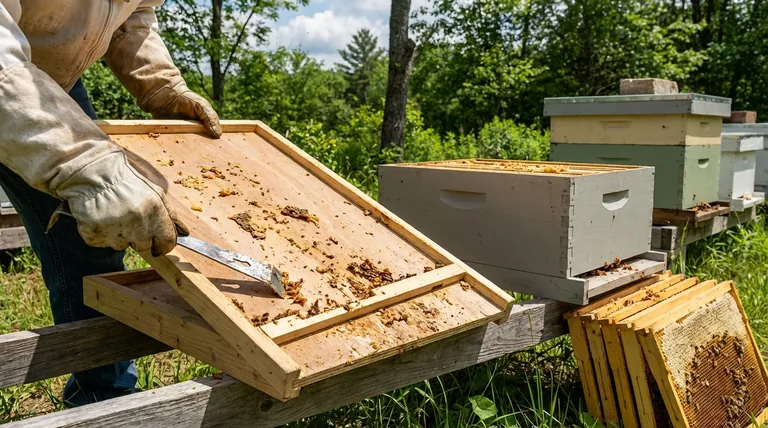To clean a beehive bottom board, you must first set the hive bodies aside, then use a metal hive tool or scraper to remove all accumulated debris from the surface. This simple act of maintenance is most effective when performed a few times a year, particularly in the early spring and fall.
Cleaning your hive's bottom board is more than simple housekeeping; it's a critical opportunity to inspect for pests and disease, directly impacting the long-term health and stability of your colony.

The Role of the Bottom Board in Hive Health
A hive's bottom board is the foundation of the entire structure. It serves as the floor of the colony and provides the primary entrance and exit for all bee activity.
The Foundation and Entrance
The bottom board supports the full weight of the brood boxes and honey supers. It's the takeoff and landing platform for all foraging bees.
Proper installation is key. The board should be placed on a firm, raised surface and tilted slightly forward to ensure rainwater drains out, rather than pooling inside the hive.
A Critical Point of Defense
For smaller or younger colonies, the entrance on the bottom board can be a point of vulnerability. Beekeepers often install an entrance reducer to shrink the opening.
This makes the space easier for the guard bees to defend against intruders like mice, hornets, or robbing bees from other colonies.
A Practical Guide to Cleaning
Regular cleaning prevents the buildup of debris that can harbor pests and pathogens. The timing and method are straightforward but important.
When to Clean
The two most critical times for cleaning are early spring and fall.
A spring cleaning removes winter debris and any bees that did not survive, giving the colony a fresh start for the new season. A fall cleaning prepares the hive for winter, removing potential havens for pests.
The Cleaning Process
First, carefully lift and set aside the hive bodies (brood boxes and supers) onto a temporary stand or spare hive cover. This exposes the bottom board.
Using a sturdy hive tool or metal scraper, firmly scrape away all accumulated debris. This includes wax cappings, pollen, dead bees, and other detritus. This material should be removed from the apiary to avoid attracting pests.
Understanding the Trade-offs: Solid vs. Screened Boards
The type of bottom board you use directly influences hive ventilation, pest management, and your cleaning routine.
The Case for Solid Bottom Boards
A solid bottom board is a simple, traditional piece of wood. It is often cheaper to build or purchase.
Some beekeepers believe it helps the colony build up faster in the spring by retaining more heat, which can encourage earlier brood rearing. It also prevents pests from entering the hive from underneath.
The Advantages of a Screened Bottom Board
A screened bottom board features a wire mesh floor, significantly improving hive ventilation, which is crucial in hot or humid climates.
Its primary benefit is in pest control. Varroa mites, a major threat to honey bees, that fall off a bee will drop through the screen and out of the hive, unable to climb back up to find a new host. This makes a screened board a key tool in integrated pest management.
Making the Right Choice for Your Apiary
Your choice of equipment should align with your management philosophy and local climate.
- If your primary focus is on a traditional, low-cost setup in a colder climate: A solid bottom board is a reliable and effective choice.
- If your primary focus is on modern pest management and superior ventilation: A screened bottom board is the superior option for promoting colony health.
Ultimately, keeping your equipment clean is a fundamental step in responsible and successful beekeeping.
Summary Table:
| Cleaning Aspect | Key Details |
|---|---|
| Best Time to Clean | Early Spring & Fall |
| Primary Tool | Metal Hive Tool or Scraper |
| Main Goal | Remove debris, inspect for pests/disease |
| Bottom Board Types | Solid (traditional, retains heat) vs. Screened (improves ventilation & mite control) |
Ensure your apiary's success with professional-grade equipment from HONESTBEE. We supply durable, reliable beekeeping supplies and equipment—including solid and screened bottom boards—to commercial apiaries and beekeeping equipment distributors through our wholesale-focused operations. Proper equipment is the foundation of a healthy colony. Let's discuss your needs and how we can support your operation's growth. Contact HONESTBEE today!
Visual Guide

Related Products
- Langstroth Solid Bottom Board for Beekeeping
- Langstroth Screen Bottom Board for Beekeeping Wholesale
- Australian Pine Wood Langstroth Screen Bottom Board for Wholesale
- HONESTBEE Classic Pry Bar Hive Tool with High Visibility Finish for Beekeeping
- Professional Drop-Style Hive Handles for Beekeeping
People Also Ask
- How is the solid bottom board constructed to ensure durability? Built for Longevity with Quality Wood & Beeswax
- What factors should be considered when choosing between a solid and screened bottom board? Make the Right Choice for Your Hive's Health
- What are the characteristics of a solid bottom board? A Guide to Hive Foundation & Climate Control
- What is the purpose of a solid bottom board in a hive? Essential for Winter Survival & Insulation
- What is the recommended approach for choosing between different types of hive boards if you have multiple hives?



















